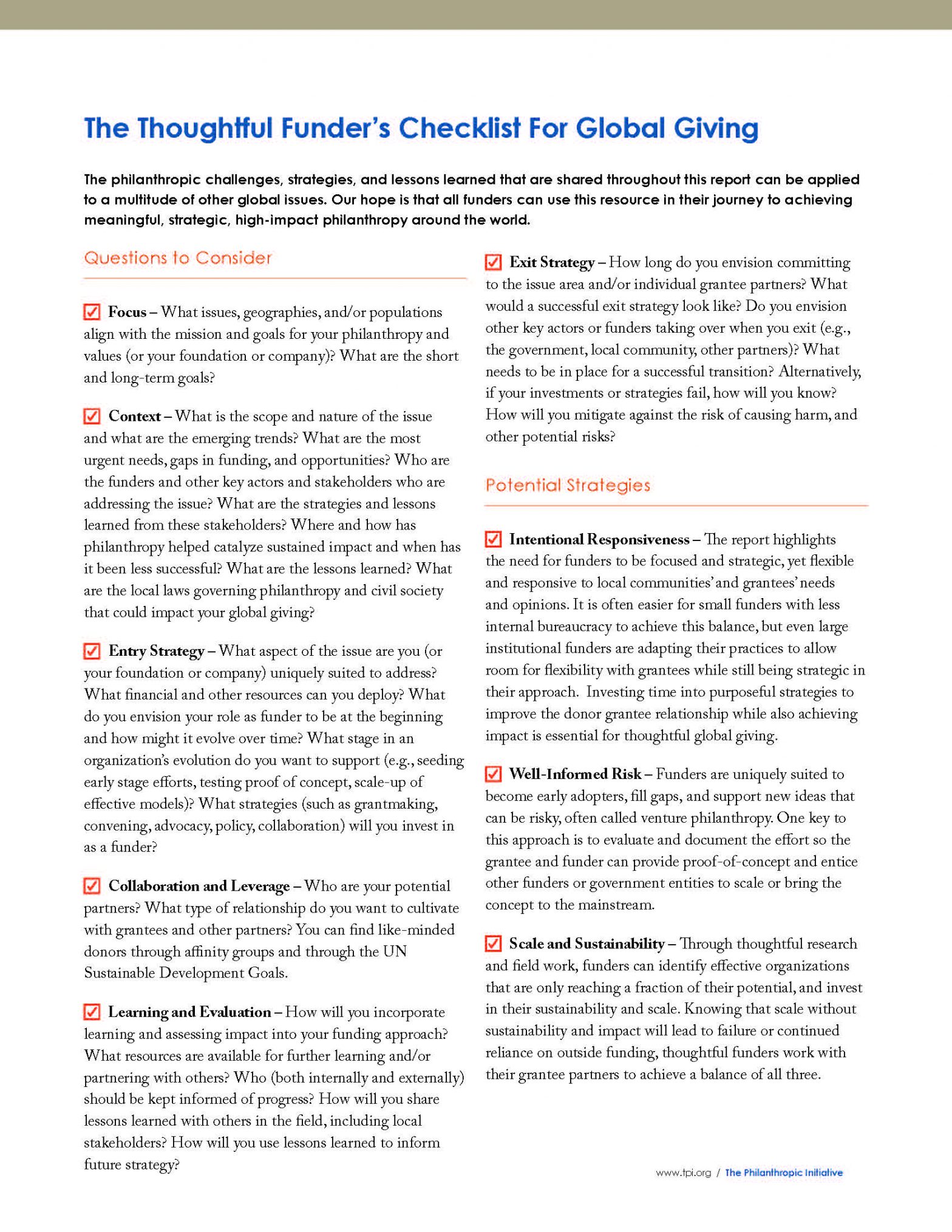
In 2019, TPI’s Center for Global Philanthropy published The Thoughtful Funder’s Guide to Global Giving. We set out to share knowledge and to equip donors of all types and sizes, from the private and corporate sectors, to determine how they might use philanthropy to address three issue areas currently affecting millions of people around the world:
I. Increasing access to clean, safe water;
II. Addressing the global refugee response crisis; and
III. Improving conditions for women and girls.
Fast forward a few months, and the world is facing a global pandemic and racial and social inequities that have laid bare just how dire these issues – and many others – truly are. The need for new ways of thinking and more effective efforts for collaboration across sectors has never been more apparent. Philanthropy has an important role to play in addressing so many of the interconnected issues facing the world today, and we’re seeing funders step up to the challenge in new and exciting ways. New collaborative platforms are being created as funders recognize the enormity of the problems and the need to work together towards solutions.
This blog post is Part 1 of a four-part series highlighting the funding strategies, challenges, and lessons learned shared in The Thoughtful Funder’s Guide to Global Giving. Check out Part 2 about Philanthropy’s Role in Increasing Access to Clean, Safe Water, and stay tuned for posts about addressing the global refugee response crisis and improving conditions for women and girls.
Whether you’re just getting started with giving across borders or you’re adjusting and reshaping your giving in response to what the world is currently facing, there are important questions worth considering in your philanthropic journey, and we’ve shared them below. We developed these strategic questions through our research for The Thoughtful Funder’s Guide to Global Giving, including conversations with a variety of funders who are having impact around the world.
Strategic Questions to Consider for your Global Giving
- Focus – What issues, geographies, and/or populations align with the mission and goals for your philanthropy and values (or your foundation or company)? What are the short- and long-term goals?
- Context – What is the scope and nature of the issue and what are the emerging trends? What are the most urgent needs, gaps in funding, and opportunities? Who are the funders and other key actors and stakeholders who are addressing the issue? What are the strategies and lessons learned from these stakeholders? Where and how has philanthropy helped catalyze sustained impact and when has it been less successful? What are the lessons learned? What are the local laws governing philanthropy and civil society that could impact your global giving?
- Entry Strategy – What aspect of the issue are you (or your foundation or company) uniquely suited to address? What financial and other resources can you deploy? What do you envision your role as funder to be at the beginning and how might it evolve over time? What stage in an organization’s evolution do you want to support (e.g., seeding early stage efforts, testing proof of concept, scale-up of effective models)? What strategies (such as grantmaking, convening, advocacy, policy, collaboration) will you invest in as a funder?
- Collaboration and Leverage – Who are your potential partners? What type of relationship do you want to cultivate with grantees and other partners? You can find like-minded donors through affinity groups and through the UN Sustainable Development Goals.
- Learning and Evaluation – How will you incorporate learning and assessing impact into your funding approach? What resources are available for further learning and/or partnering with others? Who (both internally and externally) should be kept informed of progress? How will you share lessons learned with others in the field, including local stakeholders? How will you use lessons learned to inform future strategy?
- Exit Strategy – How long do you envision committing to the issue area and/or individual grantee partners? What would a successful exit strategy look like? Do you envision other key actors or funders taking over when you exit (e.g., the government, local community, other partners)? What needs to be in place for a successful transition? Alternatively, if your investments or strategies fail, how will you know? How will you mitigate against the risk of causing harm, and other potential risks?
The philanthropic challenges, strategies, and lessons learned that are shared throughout The Thoughtful Funder’s Guide to Global Giving can be applied to a multitude of global issues. Our hope is that all funders can use this resource in their journey to achieving meaningful, strategic, high-impact philanthropy around the world. And whatever your area of focus is, it’s helpful to remember the six Powerful Practices used by thoughtful funders as unearthed through our research for this guide. These ideas are not new, but they continue to re-emerge as core values and principles to guide more ethical and participatory cross-border philanthropy.
—
Click here to learn more about TPI’s Center for Global Philanthropy and our work supporting funders of all kinds who wish to effectively give around the world. The Center supports individuals, families, foundations, and companies to have an impact through their giving. Contact us to learn more about how we help funders and companies do more and better giving worldwide.


